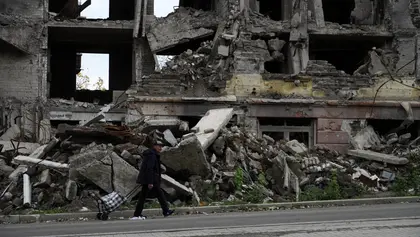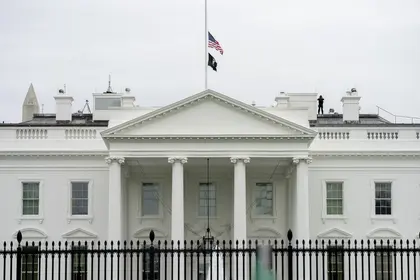We are now witnessing World War III, and Europe is in the thick of it.
No, this is not the antechamber to nuclear Armageddon. Quite simply, any major war in a globalized economy will have a ripple effect across the planet. Yet this Russo-Ukrainian War must be viewed as World War III because that’s how Moscow sees it.
JOIN US ON TELEGRAM
Follow our coverage of the war on the @Kyivpost_official.
The reality is that the Kremlin understands this war as an existential threat – by its own warped definition. Vladimir Putin is acutely aware of the fact that his regime is now in grave danger, with all the world’s powers either against it – like the U.S. and EU – or unwilling to explicitly ally themselves with Moscow – such as India and China.
- Find the newest Ukraine news pieces that came out today.
- Access the newest Ukraine news items published today.
Of course, it is only Putin’s regime that is in danger. Russia will survive. It’s huge. It spreads across 11 time zones. Trying to destroy it would be a fool’s errand, and neither Ukraine nor NATO has any intention of doing so.
But Putin’s own power over Russia, his “Russian world” ideology, and the fantasy of a Great Russia regaining its erstwhile influence over much of Europe and Asia are rehearsing their last gasps.
Nevertheless, as far as the fighting is concerned, how Putin defines the war is what counts. Because he is the one who launched it, and he is the one who will be forced to stop it.
Putin’s hybrid war
Even before the initial invasion that started this war in 2014, Russia had been pursuing what’s come to be known as a “hybrid war” against the West. It consists not just of bombs and tanks, but also gas supplies, cyberattacks, and information warfare.

Ukraine’s Defense Minister Heads to South Korea With Weapons Wish List
As Gen. Valery Gerasimov, now the chief of Russia’s armed forces, put it in a 2013 manifesto mapping out what has come to be known as the “Gerasimov Doctrine”: “In the 21st century, we have seen a tendency toward blurring the lines between the states of war and peace. Wars are no longer declared and, having begun, proceed according to an unfamiliar template.”
In the West, we still have a tendency to think in clear-cut categories: if there’s fire and smoke, then we’re at war; if it’s only information, then it’s just propaganda. Putin, on the other hand, has always liked to work in the gray areas.
Since Russia is well aware of being militarily and economically outgunned by NATO countries, it has consciously set out on a path of asymmetrical hybrid war. The strategy is to undermine European unity and break the transatlantic alliance in order to progressively erode U.S. hegemony over Europe and the world economy.
Gerasimov continues: “The very ‘rules of war’ have changed. The role of nonmilitary means of achieving political and strategic goals has grown, and, in many cases, they have exceeded the power of force of weapons in their effectiveness.”
Europe needs to act faster
On March 20 the EU agreed “in line with Ukraine’s urgent needs… on a three-track approach with the aim to, in particular, speed up the delivery and joint procurement aiming at one million rounds of artillery ammunition for Ukraine in a joint effort within the next twelve months, and calls for the swift implementation of these three tracks which are interlinked and need to be pursued in parallel and in a coordinated way.”
In all fairness, Europe’s ability to remain united thus far has been an edifying surprise. All the same, the sheer bureaucratic weight of the declaration’s opening sentence above should give the reader an idea of how quickly all this ammunition will reach the battlefield. Although “joint procurement” is explicitly mentioned, there will certainly be a debate as to which countries will be the source of any procurement.
In fact, Polish Prime Minister Mateusz Morawiecki has already said in an interview with Polish radio RMF FM that he plans to convince EU partners of the need for joint purchases of ammunition outside Europe.
“In Brussels, it is an open secret that there is no ammunition in Europe. On the other hand, there are several regions in the world, such as South Korea and Israel, where there are many more such munitions. That is why I expect that our joint discussions with the European Commission, several key countries, Germany and France, will lead to a quick receipt of ammunition, because Ukraine needs it here and now.”
But according to Morawiecki, France is currently opposing the purchase of ammunition outside the EU.
In his analysis of the EU announcement, Kyiv Post senior defense correspondent Stefan Korshak allowed himself a flight of uncharacteristic sarcasm in his milblog.
“From where I come from a bureaucrat saying ‘we’re great, we had a bunch of meetings and we agreed on some stuff faster than we usually do’ is not an achievement, but a textbook definition of bloated bureaucracy that wastes taxpayer money and resists reform and efficiency. Meetings are not a real-world outcome. A result… is when the shells get to the units.”
To hammer the same point home, within days of the EU announcement Volodymyr Zelensky told the Japanese newspaper Yomiuri Shimbun that the situation in eastern Ukraine was “not good,” adding that: “We are waiting for ammunition to arrive from our partners.”
Unity is key
Since 2014, Europe has consistently been reluctant to act in any way that would induce Moscow to escalate its aggression against Ukraine. Over the past nine years, the Kremlin has shrewdly taken advantage of Europe’s skittishness.
Yet since the full-scale war began, European unity has been one of the main bulwarks preventing Russian success – although it is arguable as to who deserves the credit.
Regardless of who gets credit, EU unity will defeat Russia. But only if that unity is translated into a concerted, timely effort whereby the entire continent puts itself on a war footing economically. The EU has already shifted away from its reliance on Russian gas – notwithstanding a chorus of Cassandras. Now it must dismiss all the obviously disingenuous cries for “ceasefire and negotiation” and ramp up defense spending to help Ukraine.
Thus far only seven NATO countries – the U.S., U.K., Poland, Estonia, Greece, Latvia and Lithuania – have reached the goal of each nation spending at least 2 percent of its GDP on defense. Perhaps this could be achieved more quickly if Europe were to shift its point of view to that of its enemy: admitting not just that this is World War III, but also that it is eminently winnable by supporting Ukraine.
Ukrainians are confident that they can evict the Russians from all their territory without any non-Ukrainian boots on the ground. But they will not be able to do it without heavy weapons and economic assistance.
This window of opportunity, however, will not last long. Europe needs to move fast and dismantle some of its built-in bureaucratic speed bumps – and it must be done while Russia is exhausting its resources and Ukraine still has the will and strength to launch what will be a difficult offensive to rid itself of the scourge of Putin’s regime.
Otherwise, Europe will be next.
The views expressed in this opinion article are the author’s and not necessarily those of Kyiv Post.
You can also highlight the text and press Ctrl + Enter






